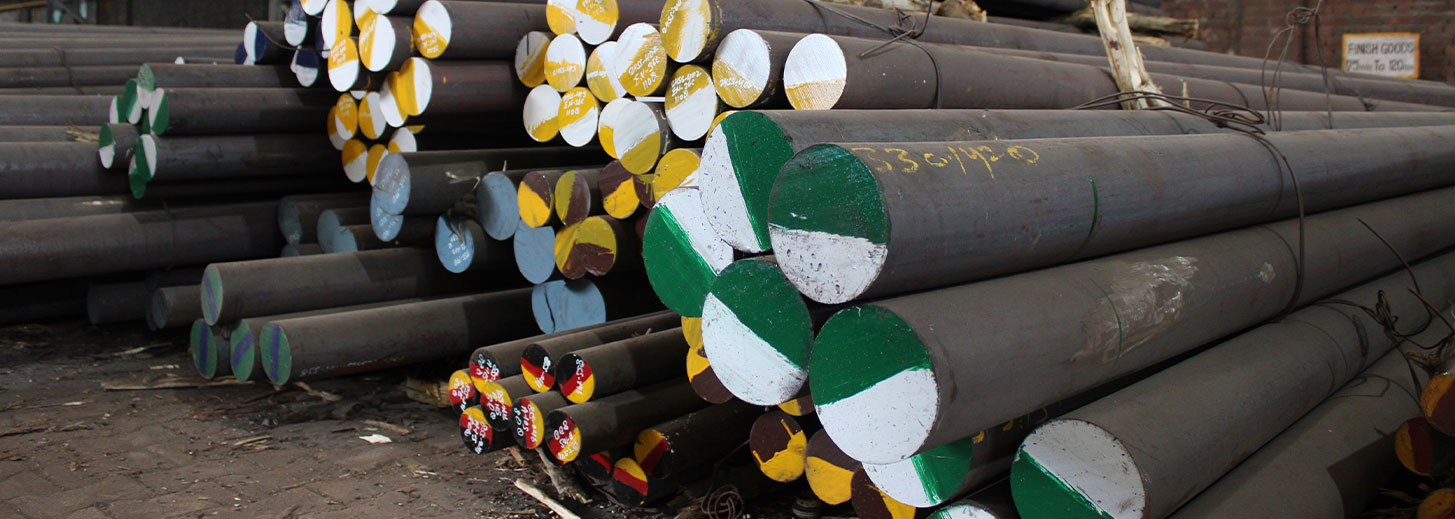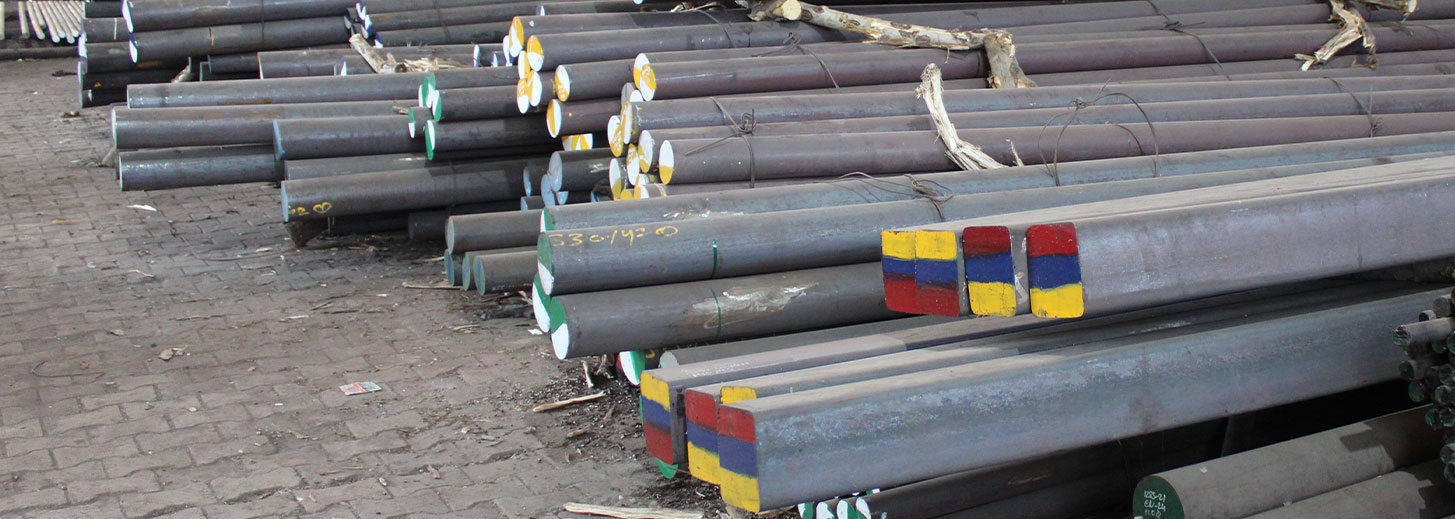Get in touch!
Village Chanalon, Tohra RoadSirhind-140406, Distt. Fatehgarh Sahib, Punjab
Allied Concern
Mfrs. of : Flats, Rounds, Square Bars & RCS etc. R.G. Mill Road, Mandi Gobindgarh-147301 (Pb.)
One of the our most productive and versatile materials is steel. Although iron (Fe) and carbon (C) make up the majority of steel, modern steel is more sophisticated than that. The amount of carbon and iron in steel as well as the addition of other components can change its properties and strength, making steel useful in a wide range of situations.
Most people believe that steel is just a set combination of iron and carbon. But there are in fact over 3,500 different grades of steel! You can determine the grade of steel by analyzing the quantity of carbon in it, the other alloying elements it includes as well as how it’s processed. we’ll discuss the four different types of steel, along with how they’re classified, the various steel grades and the methods of heat treatment used to improve steel’s mechanical properties.


Aside from carbon and iron, carbon steels contain only trace amounts of other elements. Carbon steels are the most frequent of the four steel classes, comprising 90% of total steel production! Carbon steel is divided into three subgroups according on the quantity of carbon in the metal:
Companies usually make these steels in huge quantities because they are relatively affordable and strong enough for large-scale construction.

Alloy steels are produced by combining steel with other alloying elements including nickel, copper, chromium, and/or aluminum. A combination of these components improves the steel's strength, ductility, corrosion resistance, and machinability.

Stainless steel grades are alloyed with 10-20% chromium, nickel, silicon, manganese, and carbon. Because of their increased ability to endure adverse conditions, these steels have exceptionally high corrosion resistance and are suitable for use in outdoor construction. Stainless steel grades are also often utilized in electrical electronic equipment. While different stainless steel grades, including 304 stainless steel, have their uses in buildings, stainless steel is more commonly sought after for its sanitary features.
These steels are commonly used in medical devices, pipes, pressure vessels, cutting tools, and food processing equipment.

Tool & Die Steels, as the name implies, are ideal for cutting and drilling equipment. The addition of tungsten, molybdenum, cobalt, and vanadium enhances heat resistance and overall durability. They are also the chosen material for most hand tools since they retain their shape even after extensive use.

Steel grading systems allow us to categorize steel variants based on their application. The amount of time they can keep steel at critical temperatures during the cooling process is also important. In actuality, two sheets of steel with the same alloy content might have different grades depending on how they are heat treated. The ASTM Grading System assigns each metal a letter prefix based on its general category ("A" for iron-based alloys and steel materials) as well as a sequentially assigned number that corresponds to the metal's distinct properties.
The SAE Grading System classifies items using a four-digit number. The first two numerals represent the steel type and alloying element concentration, while the last two digits indicate the metal's carbon content. Scientists, Engineers, Architects, Automotive Engineers, and Government Agencies routinely employ steel grading standards to ensure material quality and consistency. These standards provide standardized vocabulary for describing the properties of steel in great detail, as well as guidance to product producers on appropriate processing and application processes.
It is essential to comprehend what microstructure means and how post-manufacturing, hot and cold forming, and other processes can alter the microstructure of steel. Products with distinctive mechanical properties can be made utilizing these techniques. On the other side, altering the microstructure and chemical composition will require sacrificing certain unique characteristics. Although the microstructure is invisible to the naked eye, it can be examined under a microscope. Numerous microstructures, such as ferrite, pearlite, martensite, cementite, and austenite, are possible in steel.
FerriteFerrite is the name for the molecular structure of pure iron at room temperature. Extremely low carbon steel will also have this microstructure. The ferrite's unique crystal structure is a body-centered cubic (BCC) structure. In comparison to other microstructures where there are more molecules per cube, BCC's molecules are more loosely packed. However, at ambient temperature, just 0.006% of carbon can be added without compromising the ferrite microstructure.
AusteniteWhen iron-based alloys are heated over 1500 degrees Fahrenheit but below 1800 degrees Fahrenheit (982 degrees Celsius), a microstructure known as austenite is produced. The steel will maintain its microstructure even after cooling if the right alloy, such nickel, is present. A typical microstructure of stainless steel, austenite, has a maximum carbon content of 2%. The face-centered cubic (FCC) crystal structure of austenite sets it apart. Compared to ferrite, austenite has more tightly packed molecules.
CementiteThe microstructure returns to ferrite when carbon steel is heated to austenite temperatures and then cooled without any alloy present to preserve the austenite shape. Because there is ferrite in some of the material, cementite cannot develop on its own. But if the carbon content rises over 0.006%, the extra carbon atoms combine with the iron to form iron carbide (Fe3C), which is also referred to as cementite.
PearliteCementite and ferrite are layered alternately to form the laminated substance known as pearlite. It takes place when steel is gradually chilled, creating a eutectic mixture. When two molten materials crystallize simultaneously, they form a eutectic mixture. In these circumstances, ferrite and cementite crystallize simultaneously, giving rise to alternate layers in the microstructure.
MartensiteThe crystalline structure of martensite is tetragonal and body-centered. Steel is quickly cooled to produce this microcrystalline state, which keeps carbon atoms inside the iron lattice. The result is an iron and carbon structure that resembles a needle. Martensite microcrystalline steel is usually a low-carbon steel alloy with a chromium content of roughly 12%.
Hot and cold formingSteel that is still molten needs to be finished and shaped into its final shape in order to stop corrosion. Often, steel is cast into machine-ready shapes like slabs, billets, and blooms. The casts are then shaped by rolling. Rolling can be done in a hot, warm, or cold temperature, depending on the material and intended use. Two work rolls are used during rolling to accomplish compression deformation. The steel is pulled and squeezed between the rapidly rotating rolls.
Cold formingRolling steel at a temperature below its melting point is known as cold forming. Grain formation in the material is caused by dislocations in the microstructure of the steel caused by the pressure of the rolls on it. Steel becomes tougher and harder to deform as the number of dislocations rises. The steel becomes brittle as a result of cold rolling, although heat treatment can fix this.
Following rolling, the steel pieces undergo further processing to strengthen their resistance to corrosion and enhance their mechanical qualities. Examples of these processes include:
Spheroidization occurs when carbon steel is heated for thirty hours to 1290°F/699°C. The cementite layers in the pearlite microstructure transform into spheroid forms, giving rise to the softest and most ductile form of steel.
Full annealingAfter an hour of heating just above the highest critical temperature, carbon steel is annealed at a rate of around 36°F (2°C) per hour. This process produces a flexible, coarse pearlitic structure devoid of internal stresses.
Process annealingProcess annealing reduces stress in cold-worked, low-carbon steel (> 0.3% C). The steel is heated to 1025–1292°F (552–700°C) for an hour. Crystal reconstruction corrects microstructure dislocations prior to cooling.
Isothermal annealingFirst, the temperature of high-carbon steel is raised over its upper critical point. After that, the temperature is kept constant, lowered to the lower critical temperature, and then raised again. It is then progressively cooled to room temperature. Before moving on to the next chilling cycle, this process ensures that the material has reached a consistent temperature and microstructure.
NormalizingCarbon steel is heated to the normalizing temperature for one hour. The steel has now fully transitioned into the austenite phase. Air is then used to cool the steel. A fine pearlitic microstructure with great strength and hardness is the outcome of normalization.
QuenchingBy heating medium or carbon steel to the normalizing temperature and quickly cooling it in water, brine, or oil, the steel is brought down to the upper critical temperature in this method. The result of the quenching procedure is a very hard but delicate martensitic structure.
Tempering quenched steelBecause the results are predictable, this heat treatment is the most widely used. Steel that has been quenched is heated and cooled to below the lower critical point. Depending on the desired outcome, different temperatures are used; nevertheless, 298–401°F (148–205°C) is the most common range.
Since the ideal steel grade for a given application relies on a number of variables, including the intended usage, mechanical and physical requirements, and budgetary constraints, there is no one "best" grade of steel that applies to all situations.
The following steel grades are commonly used and considered the best series of each type: